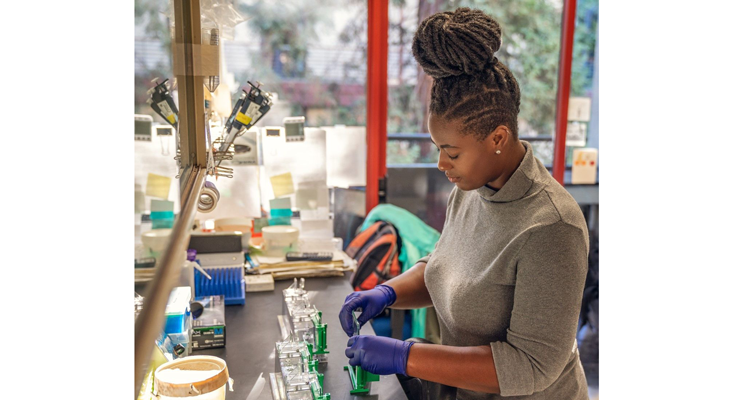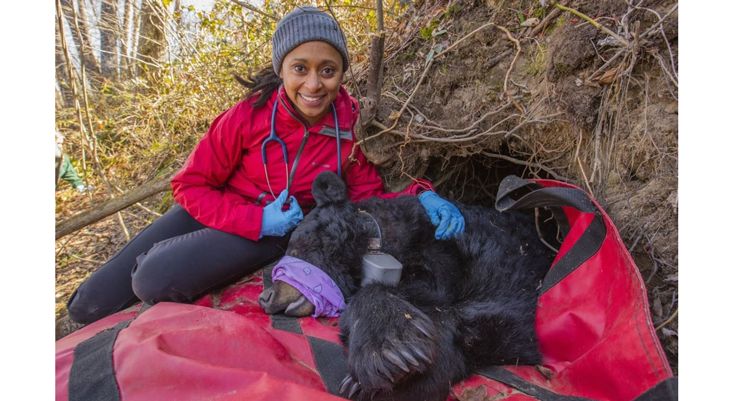
Forged in metal or chiseled in stone, statues almost always depict dead men. A recent analysis of 12 major American cities turned up only six physical representations of women. Only one of 23 statues in New York’s Central Park depicts a female, and she is a male invention: Alice, from Alice in Wonderland. Until today, that is, when six 3-D-printed statues of women were installed at the Central Park Zoo. The six statues are a pop-up sampling of 120 depictions of women scientists originally slated to debut in a grand gala setting in Dallas, Texas, an event curtailed by COVID-19. Eventually, the full panoply of figures will be celebrated.
Dorothy Tovar and Rae Wynn-Grant are among the women whose images were scanned by 89 cameras and 25 projectors to generate a 3-D image, subsequently made material by layers and layers of acrylic gel. Not only their fabrication makes them unusual. Their subjects are still living. They depict women of color who are working scientists. Their images are intended to inspire girls to pursue STEM (science, technology, engineering, and math) careers. In the language of the sponsoring project, #IfThenSheCan: “if she can see it, then she can be it.”
Dorothy Tovar, one of the statue subjects, came to science in a highly personal way. A fifth-year doctoral candidate in microbiology at Stanford University, Tovar grew up in Cambridge, Massachusetts. “My parents were immigrants from Haiti,” she said, “and I went to visit my grandmother there when I was about 5.” Upon discovering she harbored a tapeworm, Tovar “freaked out.” Her alarm was met with equanimity by her grandmother. “She made some sort of cocktail for me in the kitchen,” Tovar says, “and it took care of the tapeworm.”

“I was astonished that another creature could live inside me,” Tovar says. “As I grew up, I became more aware that what were unusual health threats to me in Cambridge were daily occurrences to people in developing nations.” Tovar’s interest in infectious disease increased alongside her commitment to social justice. She did her undergraduate studies at the University of Massachusetts Amherst. “I was going anywhere I could major in microbiology,” she laughs. She studied Chylamydia trachomatis, a bacteria spread by eye-seeking flies. “They land on people’s faces and cause infection. It is easily treated with antibiotics but lack of access means a lot of people get totally preventable blindness.” At Stanford, Tovar has been using CRIPSR-Cas9 genetic editing to help probe the origins of diseases including SARS, ebola, and our current scourge, COVID-19.
Tovar is currently back at Stanford, where in addition to research she founded the Diversity Center for Representation and Empowerment at the School of Medicine. She observes that when COVID-19 arrived, the parents of most of her peer group of Ph.D. students “simply started working at home,” a luxury not universally available. We have all witnessed the increased vulnerability of underserved populations as well as front-line health care workers. “This has opened up my colleagues’ understanding of the world,” she says. “They’ve seen the ripple effect of a human health crisis, how it impacts different people who occupy different spaces.” People for whom an escape hatch just isn’t there.
If you are a black bear or a grizzly bear, COVID-19 actually offers a reprieve from human pressures. “This is anecdotal,” says biologist Rae Wynn-Grant, “because I haven’t been able to go into the field, but it looks like bears had a great spring.” Citizen science data, including imagery from motion-activated cameras, indicate that bears were able to come out of hibernation and to forage these past few months in a setting more optimal for their needs, because humans were absent. “Mother bears were able to use ecosystems as they saw fit, and their cubs thrived,” she says.
“I study large carnivores in general,” Wynn-Grant says. “My focus in the past decade has been on North American black and grizzly bears. I study their movement and behavior, and how they use different habitats. Most of this is to better understand the ecology of bears and other carnivores, to make sure we are protecting the habitats that are truly best for them.”

There are exceptions of course—like rats—but on the whole, wildlife suffers as the human footprint expands. According to Wynn-Grant, bears are keenly attuned to where humans walk, hike, and bike. “They will avoid even protected areas if it includes a hiking trail,” she says, “and sometimes choose suboptimal habitat for hibernation, for example,” if the area is farther removed from human use.
In contrast to Dorothy Tovar, Wynn-Grant’s exposure to her professional subject came later in life. “I grew up in San Francisco,” she says. “And my family never went on wilderness trips.” Starting out on a pre-med track, she eventually found conservation biology. Having never braved the great outdoors, she took a plunge as an undergraduate and participated in a camping-based wildlife study in East Africa. “I took that trip, I put hiking boots on for the first time, and I saw my first wild animal. I didn’t turn back after that.” Wynn-Grant eventually earned a Ph.D. from Columbia University and currently works for National Geographic. “I took the academic pathway,” she says. “But there are a lot of other ways to work with and on behalf of wildlife.”
Black bears can be scary, of course, to say nothing of what a grizzly can get up to—how does she explain why we should protect these creatures? “My personal view is ethical,” she says. “All species deserve to exist and to thrive. Beyond that, there are reasons why they exist in ecosystems. When you remove top predators, herbivores like deer increase and they eat all the vegetation. That results in soil erosion, which impacts humans very directly.” Many viruses, of course, originate in populations of wild animals that evolved to withstand their negative impacts. When humans destroy habitat, viruses can be left looking for a fresh host supplied by an abundance of Homo sapiens. So it would seem that if we want to protect humans, we might want to actually look to the grizzly bears.
In keeping with their setting at the Central Park Zoo, which is also home to the Wildlife Conservation Society, the statues of Tovar and Wynn-Grant are joined by those of four women also working in the natural sciences: wildlife biologist Kris Inman, shark researcher Jess Cramp; herpetologist Earyn McGee; and bat conservationist Kristen Lear. They are scheduled to remain through October. The complete exhibit includes 122 statues, representing women working in a wide range of STEM fields. Although delayed, a comprehensive exhibit is still planned to open at North Park in Dallas.
Mary Ellen Hannibal is the author of Citizen Scientist: Searching for Heroes and Hope in an Age of Extinction, the winner of Stanford’s Knight-Risser Prize in Western Environmental Literature, and a Stanford media fellow.






























